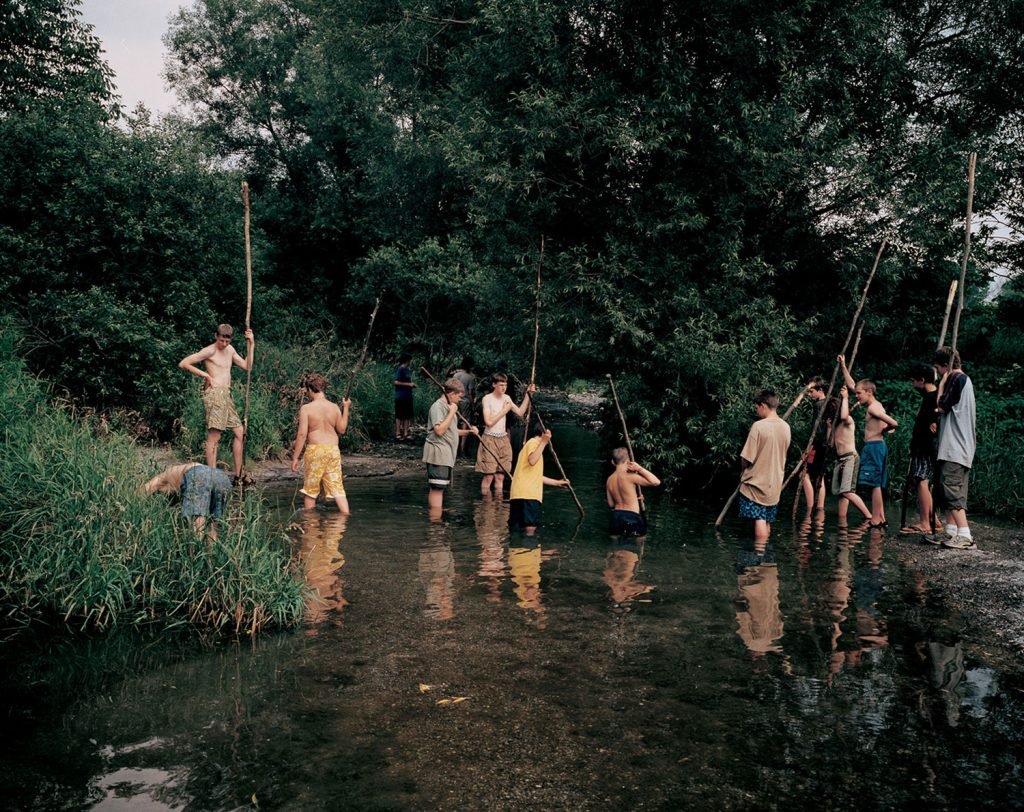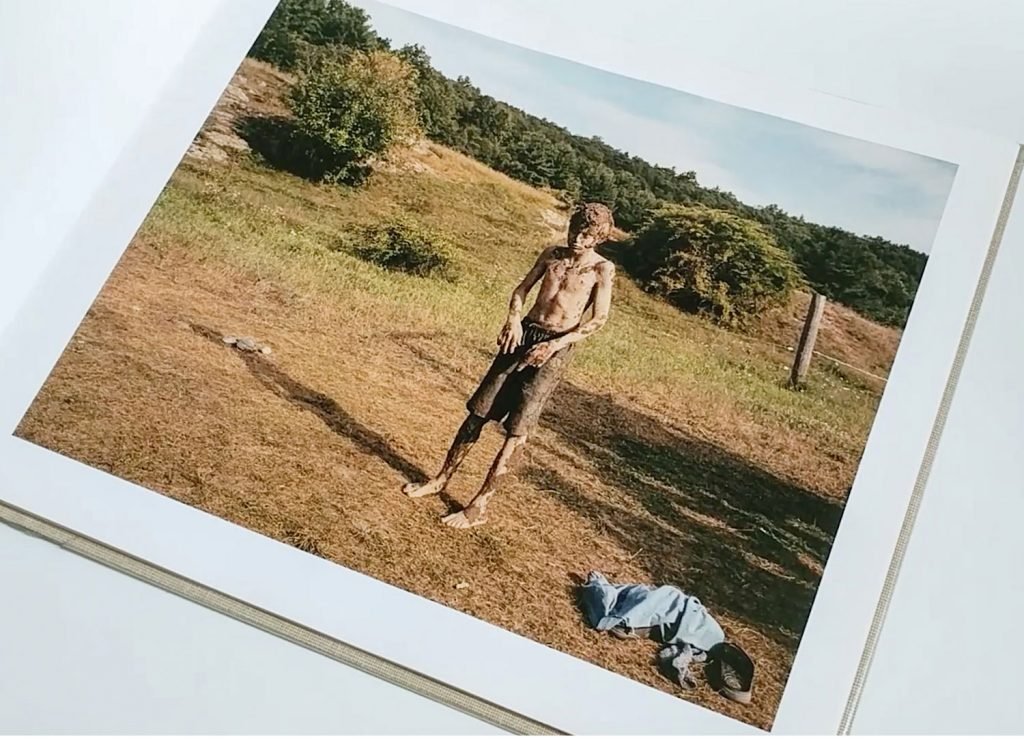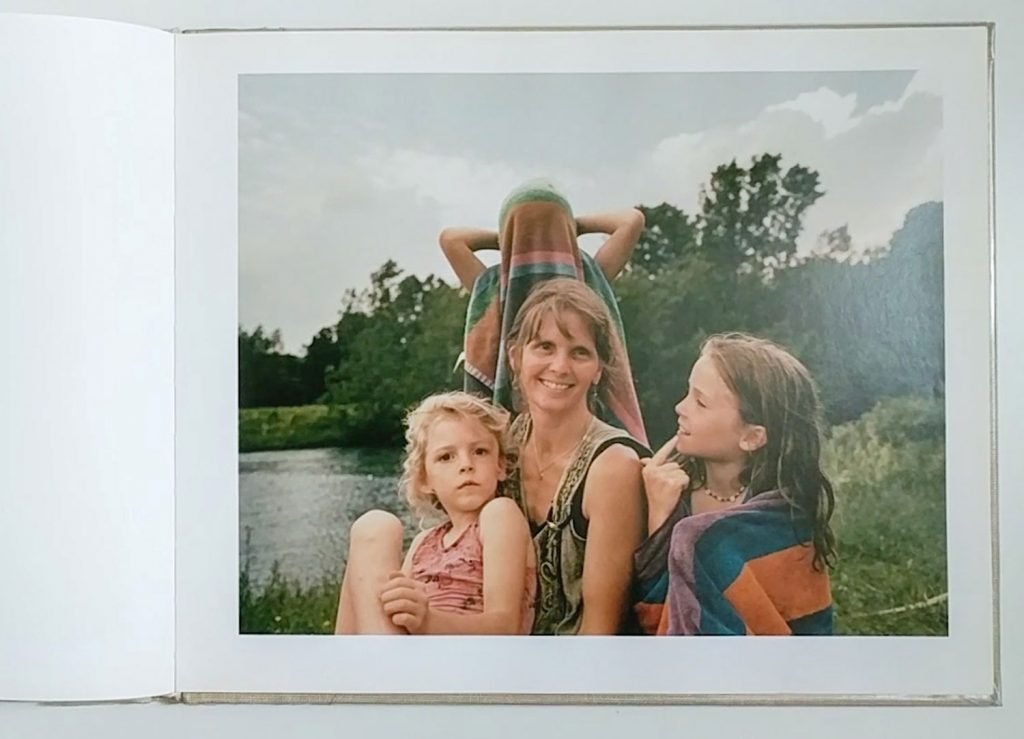Richardson first visited Harlemville (North America) on May 2000 and kept coming back over the summers of the next three years. Harlemville is a small community built around Austrian philosopher Rudolf Steiner’s educational system, named Walford Schools. A part of his wider philosophical system he called Anthroposophy. The Walford Schools system is mainly based on freedom of expression, own pace learning and multi-sensory experience. This approach to education gives equal attention to the physical, emotional, intellectual, cultural and spiritual needs of each pupil and it is designed to work in harmony with the different phases of a child’s development.
The work turns around a group of kids and their relationship with the wild nature that surrounds the community they live in. It is characterised by a very homogeneous layout and not obstructive approach that reveals itself through the colour palette, same-size pictures and the choice of showing each image on a separate spread. This book is about the delicate time of adolescence and the coming of age of a group of young men who have been given freedom of experience and a chance to interact with Nature in a way any of us hardly experience anymore.
In Richardson’s images, we assist at a joyful and playful youth that develops upon a sense of community and respect between each other and the surrounding environment. Every image seems to be taken out of a rolling camera, left there to record the kid’s experience without any sort of direction or interaction.
Main location is a river, playground as well as learning ground where their personalities develop through adult-like activities such as hunting and sheltering. This river is also a magical place for escaping the ordinary. An imaginary portal that links to the underwater world where Nature’s spirits are now tangible.
The body and its transformation is also a relevant theme of this work. Interactions with Nature happen freely and kids are most of the times feeling the ground beneath their toes and on their skin, experiencing an uninhibited connection that brings them in naked contact with their surrounding. Those bodies are seen growing, changing and transforming with the constant stream of water along the river.
A key reference to this work is William Golding’s famous novel “Lord of the Flies” and the atmosphere developed throughout this project resembles the one Golding’s readers are already familiar with. In particular, it is visible in the dynamics of power within the group of kids absorbed in their adventures and activities away from adults.
Apart from three only pictures toward the end, the kids are the main subject of this world. Moreover, the story is mainly focused on boys and only very few girls will appear toward the end, leaving some important questions unanswered.
In this picture (1), it is evident how the dynamics of power mentioned above are structuring the image. At the very centre of attention is the guy with a T-shirt wore as a bandana. He seems to be the oldest of the group, sitting in the middle in a position of authority and looking back at the two other guys nearby him working on a fishing tool. It seems like they are doing – or might have said – something the older guy does not agree with or he’s surprised to hear.
Also, away from everyone, sitting on a three-branch in a spectator position we find the two youngest of the group attentively looking and learning from the older and more experienced members.
Initiation Rituals are a recurring theme throughout the book. It is interesting to see how they work as moments of bond and development within the community, even though they occur in playful settings. The process of learning key social/life skills naturally happens within the informal frame of the game, rather than a more formal teacher-student dynamic. Those basic but essential living skills are developed by the kids, at the benefit of their future life, in straight contact with the outer world of Nature. It really amazes how playful activities can have unconscious purposes of learning the basics of living and surviving.
The texture of this picture (2) is as rich as its meanings. A boy is mud bathing somewhere in the woods. On his face, we can read the tension of his actions against his will. Nonetheless, he is almost there and everything will be finished as soon as he will let himself go. The last part of his body, his head, has to go under the mud and he has to rub himself completely, as the task might require. By the shape of the puddle and the footprints all around, we know this is a crucial moment of initiation and admission within the community of kids through which everyone must pass by.
A ritual of braveness, courage and commitment that will prove the member belongs to the group. This humiliation of the Mud Bath has the double function of submitting the individual to the group as well as proofing his strength. Looking at the scene we feel like we are one of them, among them, assisting to the ritual and almost trembling for our turn to come.
It is important to compare this image with this other one of the after-bath (3). The humiliation depicted in this member’s face and posture is the one of the single individual submitted to the supremacy of the group – perhaps, against his will. Lastly, it is crucial to notice how this Ritual of the Mud resonates very well with the multi-sensory experience and return-to-nature approach of the Walford Schools system.
Toward the end of the book, girls and adults make a brief appearance. This group of girls (4) is depicted in the act of peacefully picking up flowers. Although this is a very beautiful image, positioned at this point of the book – after only boys are seen playing and practising different activities – raises some unanswered questions. It seems like not much space of investigation is dedicated to the girls. However, it is not clear what are the reasons behind the matter. Was it because not many female members belonged to the community? Or because simply it was preferred to only focus on the boys for the propose of this work?
Moreover, this image of girls (the first one being a portrait) appears to be a very cliché activity of them dedicating their time to what for some can be a “futile” activity. It would be of great interest to know if this is part of the educational system provided by the Walford community, where boys had been specifically directed towards “boys” activities and girls towards “girls” activities. Or if perhaps, this is either the selective POV of the photographer or the direction of the editor of the book, consciously or unconsciously presenting the boys and the girls in these debatable circumstances.
One more thing happening right at the end of the book is in this picture (5). Girls are coming back from a swim and an adult figure is supervising the group. This is the first time an adult figure appears and it somehow breaks the special atmosphere the photographer had created until now. Why would adults appear supervising only the girls’ activities but not boys’ ones? And why do they even appear at all at this point?
Finally, the atmosphere created in this book has the great power of taking the viewer back to his childhood times. A time when imagination is the magnifier through which everything in our life is experienced and explained. A time of endless exploration and amazement that made us what we are now.
The layout, colour palette and absence of text perfectly serve the purpose of the book. The nostalgia of gone times holds our breaths till the end and makes this read a moment of contemplation of our own time at that age. However, it is believed the work would have benefitted of a shorter length and more focused research. In particular, introducing those few images of the girls at the end created a felt imbalance within the narrative, provoking questions around gender identity not easily explained.
Nonetheless, it is remarkable how unobtrusive and absent the approach to this work is, allowing the story to feel like is happening right in front of the viewers’ eyes.













